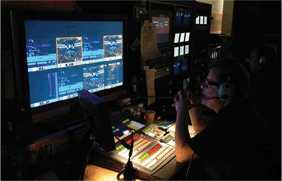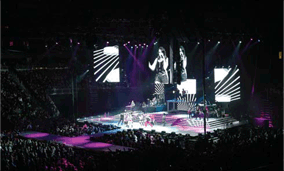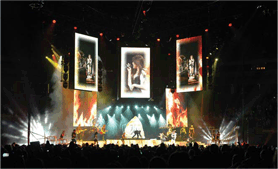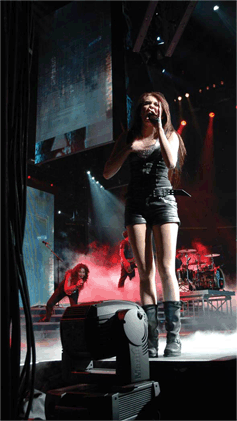CT Touring Provides Support For Miley Cyrus’s Image-Breaking World Tour
The Miley Cyrus Wonder World tour, held at Newark’s Prudential Center in early November, featured hundreds of “We Luv U Miley” posters in the audience, thousands of glow sticks, and hordes of adoring grade school girls. Hannah Montana was certain to appear. Whoa, not so fast — from the first blaring notes and the pyro, this was definitely not Hannah Montana, and definitely not the Disney channel. On the contrary, as Miley broke out of a giant iceberg on stage, astonished parents (and probably tweens) got themselves a big, 120-decibel rock show — with a superb band, a first-class dance troupe, a remarkable set, and a very new image for Miley.
Dance Driven
The concept for Miley’s Wonder World tour was created by Jamal Sims, an accomplished choreographer with film and video credits ranging from So You Think You Can Dance to Hairspray.With a keen eye for what the primary demographic wanted to see, Sims envisioned a highly theatrical show complete with gags, set changes, costume changes, foy rigs, flying motorcycles, and lots of high-energy dance.
To actualize these concepts, Jamal turned to Sean Burke, the show’s LD, video designer, and set designer, and to Richard Turner, the mastermind behind the tour’s video content. Their palette was a basic flat stage with risers and a Tshaped thrust, but the stage itself included trap doors and elevators to accommodate the multiple stunts. From the truss, complete with 125 rigging points and over 135,000 pounds of gear, ten LED video screens were suspended — each controlled by computerized winches. The three central screens formed a three-sided box that lowered to create backdrops, while simultaneously concealing dramatic “reveals” throughout the show. The two wing LED screens were double-sided, enabling the audience to enjoy the show’s video from any angle. Los Angeles-based CT Touring provided equipment and technology, and packed it all into 22 trucks.

The Miley Cyrus Wonder World tour, held at Newark’s Prudential Center in early November was created by Jamal Sims, an accomplished choreographer.
Sean Burke effectively summed up the spark behind Sims’ dance-drive design. “Jamal has actually made it quite theatrical, because that’s what the kids want to see,” says Burke. “It works quite well for this show and especially the audience. Their attention span is far shorter, but their expectations are far higher.”
Three Rigs in One
Miley’s tour is unique in many ways, but foremost is the fact that there are multiple gags per song. This posed some challenges for the LD. “Yes, it’s nuts, but it’s interesting,” explains Burke. “Because of the way the screens move up and down, you actually lose huge portions of the lighting rig during certain songs. Things get in the way. To combat this, it’s as if I have three different rigs up there. I’ve got one set of lights on the floor for certain songs, an entire truss at the back that is used when the video walls are up, and additional trusses down the sides when the walls are down.”
With credits including Seal, programming shows for the Rolling Stones, and programming lights for the Stones’ IMAX film, Burke used a Road Hog Full Boar console for Miley’s gig, but prefers another. “My favorite board is the Wholehog 2. It’s simple, it does what it says, and it does it really quick.”
Unquestionably Talented
Behind the scenes, the video system consists of four cameras (two studio and two hand-held) routed to Barco’s FSN multiformat switcher. The switcher’s output feeds the Vista Spyder screen processor, which in turn feeds the video walls with content or IMAG.

The crew has the opportunity to run Barco’s FSN switcher on its touring debut. The FSN takes any kind of video input and converts it to the native resolution. Los Angeles-based CT Touring provided equipment and technology, and packed it all into 22 trucks.
During the show, Richard Turner runs the Spyder, Robert Boynton shades cameras, and Rob Darcy directs from the switcher. As the crew’s resident “pixel pusher” (to quote Darcy), Turner’s role is unique. “I have a niche in between content creation, hardware playback, and hardware design,” says Turner. “There aren’t many people in that space.”
Within that niche, Turner used Adobe After Effects to map video to the screens. “In the early days, I started doing multimedia with 30 slide projectors and thousands of slides in carousels — all rattling around with computers,” says Turner. “Nowadays, most of what I call programming is done with After Effects. I start with a single 1920x1080 high definition canvas, and I lift pieces out of that across the screens. On the server, it all boils down to one source that’s easy to sync.”
With credits including the MTV awards, Led Zeppelin, and Genesis, Turner had high praise for Miley. “She’s a very talented girl, unquestionably,” notes Turner. “The show’s all about her, but it doesn’t upstage her. You look at the show’s layers, the choreography is amazing, the band is amazing, the lights and gags are amazing — there are at least three shows in there, any one of which might have been sufficient.”
A Touring Debut
The tour’s Production Manager, Omar Abderrahman, comments on the show’s complexity: “With previous tours like Usher or Cher, we had at most, one gag per song,” says Abderrahman. “Well, on this show, we have three and four per song. So, besides the riggers, carpenters, props, and automation guys, the most challenging part was not only figuring it out, but doing it on a nightly basis with perfect cues.”
In spite of the complexity, director Darcy’s crew enjoyed the challenge. “The fact that there’s so many moving elements, props, and reveals, it’s critically important that all the cues work right,” states Darcy. “With everything synchronized to the video, this tour is an amazing convergence of different departments — automation, lighting, rigging, sound, and video. It’s an hour and 20 minutes of sheer fun for us.”
Darcy also had the opportunity to run Barco’s FSN switcher on its touring debut. “It’s simple to use, with an easy learning curve,” says Darcy. “The fact that the FSN takes any kind of video input and converts it to the native resolution is a real advantage. Whether it’s VGA, DVI, composite, or HD-SDI, you can put anything into it.”

The stage itself included trap doors and elevators to accommodate the multiple stunts. From the truss, complete with 125 rigging points and over 135,000 pounds of gear, ten LED video screens were suspended — each controlled by computerized winches.
CT Touring’s Stephen Gray selected the FSN for that very reason. “We wanted a small and flexible system without a lot of external conversion equipment, and the FSN allowed us to do that,” notes Gray. “With previous switchers, format conversion took place outside the switcher’s frame, but the FSN has the processing built-in.”
Who She Really Is
Redo Jackson, one of Darcy’s four cameramen, comments on the aspect that not only surprised the tweens and parents, but those on the crew. In stark contrast, one type of show was expected, yet another was delivered. “We started rehearsals in September, and by October, we watched Miley morph from a little girl into a woman,” says Jackson. “In one month, with every show, she got more mature and more skilled, and the next thing we knew, a flower had blossomed. She’s not afraid to express who she really is on stage — she’s not that little girl, Hannah Montana. She’s Miley Cyrus, the woman — and we’ve all witnessed that.”
Paul Berliner is President of Berliner Productions in Davis, CA — a company providing video production and marcom services to the broadcast and entertainment industries. He can be reached at paul@berlinerproductions. com.
